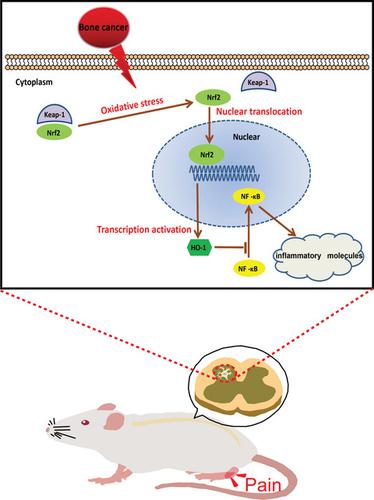当前位置:
X-MOL 学术
›
J. Neurochem.
›
论文详情
Our official English website, www.x-mol.net, welcomes your
feedback! (Note: you will need to create a separate account there.)
Spinal Nrf2 translocation may inhibit neuronal NF-κB activation and alleviate allodynia in a rat model of bone cancer pain
Journal of Neurochemistry ( IF 4.2 ) Pub Date : 2021-07-13 , DOI: 10.1111/jnc.15468 Jie Fu 1 , Chaobo Ni 1 , Hua-Dong Ni 1 , Long-Sheng Xu 1 , Qiu-Li He 1 , Huan Pan 1 , Dong-Dong Huang 1 , Yan-Bao Sun 1 , Ge Luo 1 , Ming-Juan Liu 1 , Ming Yao 1
Journal of Neurochemistry ( IF 4.2 ) Pub Date : 2021-07-13 , DOI: 10.1111/jnc.15468 Jie Fu 1 , Chaobo Ni 1 , Hua-Dong Ni 1 , Long-Sheng Xu 1 , Qiu-Li He 1 , Huan Pan 1 , Dong-Dong Huang 1 , Yan-Bao Sun 1 , Ge Luo 1 , Ming-Juan Liu 1 , Ming Yao 1
Affiliation

|
Bone cancer pain (BCP) is a clinical pathology that urgently needs to be solved, but research on the mechanism of BCP has so far achieved limited success. Nuclear factor erythroid 2 (NFE2)-related factor 2 (Nrf2) has been shown to be involved in pain, but its involvement in BCP and the specific mechanism have yet to be examined. This study aimed to test the hypothesis that BCP induces the transfer of Nrf2 from the cytoplasm to the nucleus and further promotes nuclear transcription to activate heme oxygenase-1 (HO-1) and inhibit the activation of nuclear factor-kappa B (NF-κB) signalling, ultimately regulating the neuroinflammatory response. Von-Frey was used for behavioural analysis in rats with BCP, whereas western blotting, real-time quantitative PCR (RT-PCR) and enzyme-linked immunosorbent assay (ELISA) were used to detect molecular expression changes, and immunofluorescence was used to detect cellular localization. We demonstrated that BCP induced increased Nrf2 nuclear protein expression with decreased cytoplasmic protein expression in the spinal cord. Further increases in Nrf2 nuclear protein expression can alleviate hyperalgesia and activate HO-1 to inhibit the expression of NF-κB nuclear protein and inflammatory factors. Strikingly, intrathecal administration of the corresponding siRNA reversed the above effects. In addition, the results of double immune labelling revealed that Nrf2 and NF-κB were coexpressed in spinal cord neurons of rats with BCP. In summary, these findings suggest that the entry of Nrf2 into the nucleus promotes the expression of HO-1, inhibiting activation of the NF-κB signalling pathway, reducing neuroinflammation and ultimately exerting an anti-nociceptive effect.
中文翻译:

脊髓 Nrf2 易位可能抑制神经元 NF-κB 激活并减轻骨癌疼痛大鼠模型中的异常性疼痛
骨癌痛(BCP)是一个亟待解决的临床病理学问题,但迄今为止对BCP机制的研究取得了有限的成功。核因子红细胞2(NFE2)相关因子2(Nrf2)已被证明与疼痛有关,但其在BCP中的参与及其具体机制仍有待研究。本研究旨在验证BCP诱导Nrf2从细胞质转移到细胞核并进一步促进核转录以激活血红素加氧酶-1(HO-1)并抑制核因子-κB(NF-κB)激活的假设。 )信号传导,最终调节神经炎症反应。采用Von-Frey对BCP大鼠进行行为学分析,采用蛋白质印迹、实时定量PCR(RT-PCR)和酶联免疫吸附试验(ELISA)检测分子表达变化,采用免疫荧光检测细胞定位。我们证明,BCP 诱导脊髓中 Nrf2 核蛋白表达增加,同时细胞质蛋白表达减少。 Nrf2核蛋白表达进一步增加可减轻痛觉过敏并激活HO-1抑制NF-κB核蛋白和炎症因子的表达。引人注目的是,鞘内注射相应的 siRNA 可逆转上述效果。此外,双重免疫标记结果显示,BCP大鼠脊髓神经元中Nrf2和NF-κB共表达。总之,这些发现表明Nrf2进入细胞核促进HO-1的表达,抑制NF-κB信号通路的激活,减少神经炎症并最终发挥抗伤害作用。
更新日期:2021-08-26
中文翻译:

脊髓 Nrf2 易位可能抑制神经元 NF-κB 激活并减轻骨癌疼痛大鼠模型中的异常性疼痛
骨癌痛(BCP)是一个亟待解决的临床病理学问题,但迄今为止对BCP机制的研究取得了有限的成功。核因子红细胞2(NFE2)相关因子2(Nrf2)已被证明与疼痛有关,但其在BCP中的参与及其具体机制仍有待研究。本研究旨在验证BCP诱导Nrf2从细胞质转移到细胞核并进一步促进核转录以激活血红素加氧酶-1(HO-1)并抑制核因子-κB(NF-κB)激活的假设。 )信号传导,最终调节神经炎症反应。采用Von-Frey对BCP大鼠进行行为学分析,采用蛋白质印迹、实时定量PCR(RT-PCR)和酶联免疫吸附试验(ELISA)检测分子表达变化,采用免疫荧光检测细胞定位。我们证明,BCP 诱导脊髓中 Nrf2 核蛋白表达增加,同时细胞质蛋白表达减少。 Nrf2核蛋白表达进一步增加可减轻痛觉过敏并激活HO-1抑制NF-κB核蛋白和炎症因子的表达。引人注目的是,鞘内注射相应的 siRNA 可逆转上述效果。此外,双重免疫标记结果显示,BCP大鼠脊髓神经元中Nrf2和NF-κB共表达。总之,这些发现表明Nrf2进入细胞核促进HO-1的表达,抑制NF-κB信号通路的激活,减少神经炎症并最终发挥抗伤害作用。









































 京公网安备 11010802027423号
京公网安备 11010802027423号